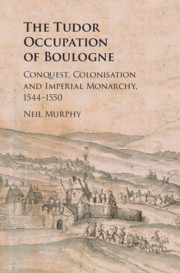Book contents
- The Tudor Occupation of Boulogne
- The Tudor Occupation of Boulogne
- Copyright page
- Dedication
- Contents
- Figures and Maps
- Preface
- Acknowledgements
- Abbreviations
- 1 The Conquest of Boulogne and the History of Tudor England
- 2 Violence and the Campaign of 1544–1546
- 3 Conquest, Cartography and Treaty
- 4 The Settlement of the Boulonnais
- 5 The Boulogne Garrison
- 6 The Tudor Occupation of Boulogne and English Imperialism
- Bibliography
- Index
6 - The Tudor Occupation of Boulogne and English Imperialism
Published online by Cambridge University Press: 25 January 2019
- The Tudor Occupation of Boulogne
- The Tudor Occupation of Boulogne
- Copyright page
- Dedication
- Contents
- Figures and Maps
- Preface
- Acknowledgements
- Abbreviations
- 1 The Conquest of Boulogne and the History of Tudor England
- 2 Violence and the Campaign of 1544–1546
- 3 Conquest, Cartography and Treaty
- 4 The Settlement of the Boulonnais
- 5 The Boulogne Garrison
- 6 The Tudor Occupation of Boulogne and English Imperialism
- Bibliography
- Index
Summary
- Type
- Chapter
- Information
- The Tudor Occupation of BoulogneConquest, Colonisation and Imperial Monarchy, 1544–1550, pp. 230 - 255Publisher: Cambridge University PressPrint publication year: 2019



